Removal

• When working on the high voltage system, the work should be performed by technicians who have completed the relevant training. A lack of understanding of the high voltage system can lead to serious accidents due to electric shock or short circuit.
• When working on the high voltage system or related components, be sure to observe and be aware of the "Safety Precautions, Cautions and Warnings". If not, it may cause serious accidents due to electric shock or short circuit.
• When working on high voltage system, make sure to check the Personal Protective Equipment (PPE) and high voltage shut-off procedure.

Suction & Liquid Tube Assembly
1.Disconnect the battery negative ( - ) terminal and the service interlock connector.(Refer to Battery Control System - "Auxiliary 12 V Battery - 2WD")(Refer to Battery Control System - "Auxiliary 12 V Battery - 4WD")
2.Recover the refrigerant with recovery/recycling/charging equipment.(Refer to Air Conditioning - "Refrigerant Recovery/Recycling/Charging/Evacuation")
3.Drain the coolant.(Refer to Cooling System - "Coolant")
4.Remove the front trunk.(Refer to Body - "Front Trunk")
5.Disconnect the chiller hose (A).
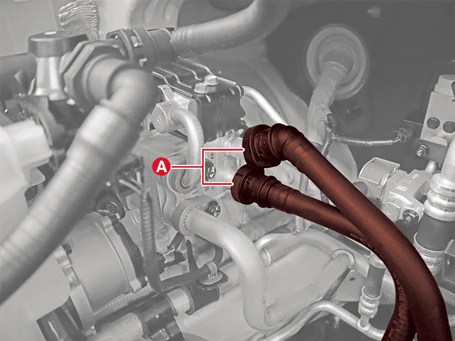
6.Disconnect the expansion valve connector (A).
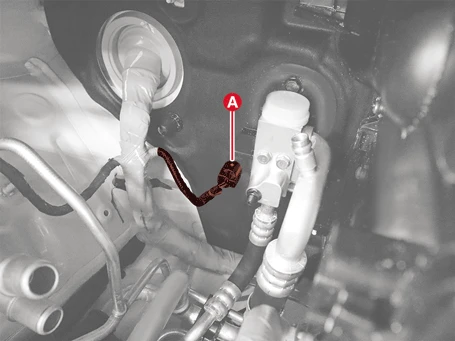
7.Disconnect the 2-way valve connector (A).
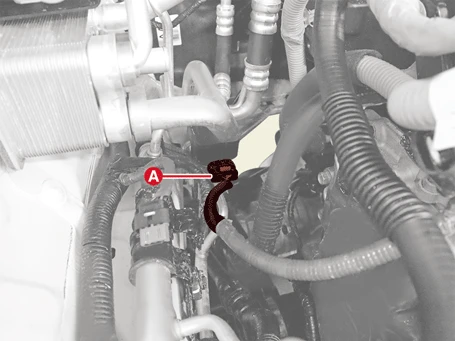
8.Separate the discharge hose assembly (A) after removing the nut.
Tightening torque :8.8 - 13.7 N·m (0.9 - 1.4 kgf·m, 6.5 - 10.1 lb·ft)
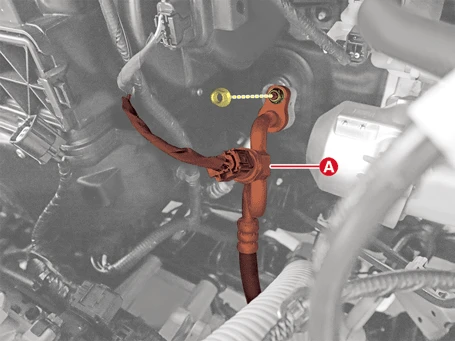
9.Separate the suction & liquid tube assembly (A) after removing the bolts and nuts.
Tightening torque :8.8 - 13.7 N·m (0.9 - 1.4 kgf·m, 6.5 - 10.1 lb·ft)
[Inner Condenser]
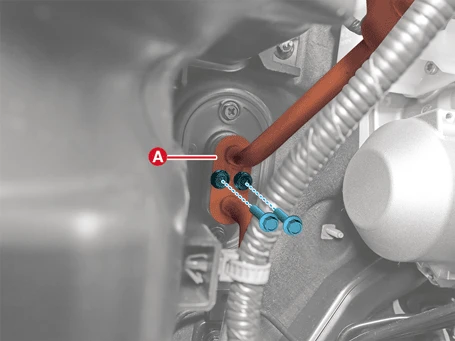
[Evaporator Core]
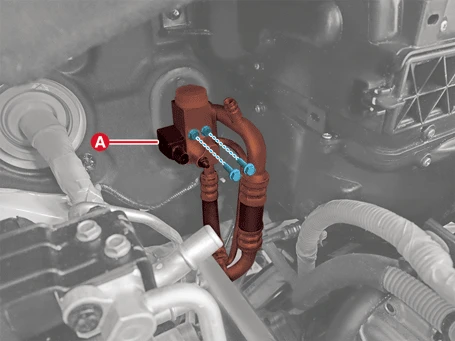
[Chiller]
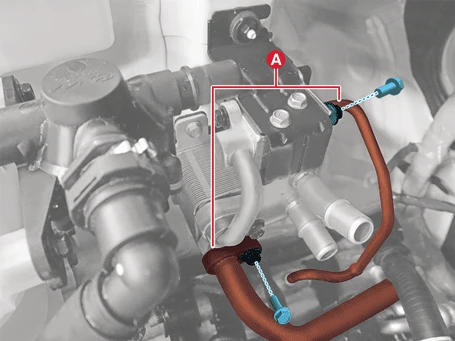
[Condenser]

[Water Condenser]
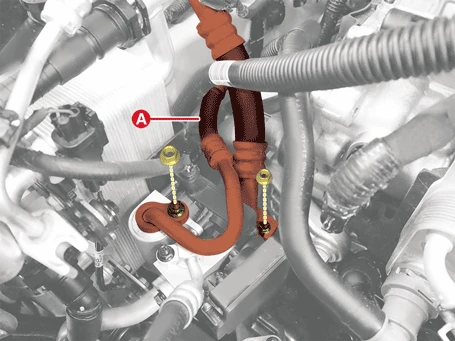
10.Remove the suction & liquid tube assembly (A) after removing the bolt.
Tightening torque :7.8 - 11.8 N·m (0.8 - 1.2 kgf·m, 5.8 - 8.7 lb·ft)
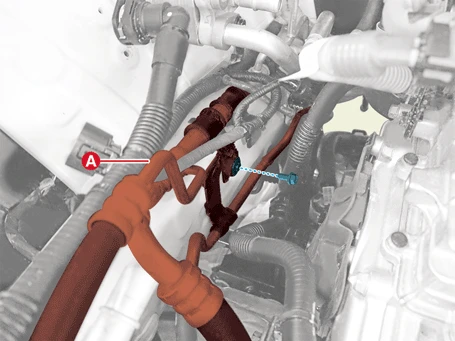
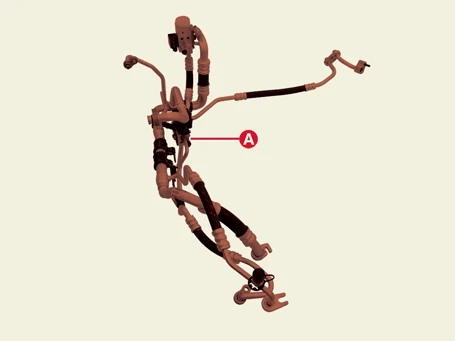
Suction Hose 1
1.Disconnect the battery negative ( - ) terminal and the service interlock connector.(Refer to Battery Control System - "Auxiliary 12 V Battery - 2WD")(Refer to Battery Control System - "Auxiliary 12 V Battery - 4WD")
2.Recover the refrigerant with recovery/recycling/charging equipment.(Refer to Air Conditioning - "Refrigerant Recovery/Recycling/Charging/Evacuation")
3.Remove the front trunk.(Refer to Body - "Front Trunk")
4.Remove the suction hose 1 (A) after removing the nuts.
Tightening torque :8.8 - 13.7 N·m (0.9 - 1.4 kgf·m, 6.5 - 10.1 lb·ft)
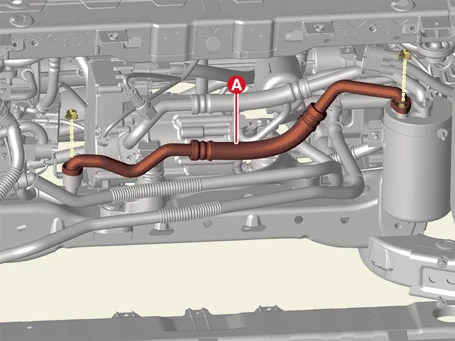
Suction Hose 2
1.Disconnect the battery negative ( - ) terminal and the service interlock connector.(Refer to Battery Control System - "Auxiliary 12 V Battery - 2WD")(Refer to Battery Control System - "Auxiliary 12 V Battery - 4WD")
2.Recover the refrigerant with recovery/recycling/charging equipment.(Refer to Air Conditioning - "Refrigerant Recovery/Recycling/Charging/Evacuation")
3.Remove the front trunk.(Refer to Body - "Front Trunk")
4.Disconnect the A/C transducer connector (A)
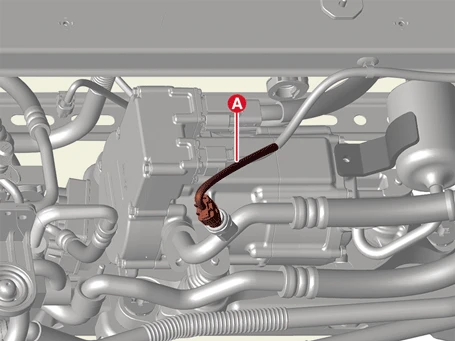
5.Remove the suction hose 2 (A) after removing the bolt and nut.
Tightening torque :Bolt : 21.6 - 32.4 N·m (2.2 - 3.3 kgf·m, 15.9 - 23.9 lb·ft)Nut : 8.8 - 13.7 N·m (0.9 - 1.4 kgf·m, 6.5 - 10.1 lb·ft)
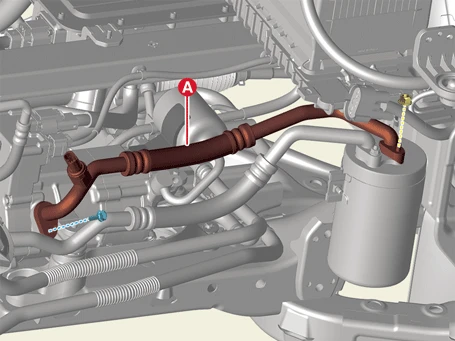
Discharge Hose
1.Disconnect the battery negative ( - ) terminal and the service interlock connector.(Refer to Battery Control System - "Auxiliary 12 V Battery - 2WD")(Refer to Battery Control System - "Auxiliary 12 V Battery - 4WD")
2.Recover the refrigerant with recovery/recycling/charging equipment.(Refer to Air Conditioning - "Refrigerant Recovery/Recycling/Charging/Evacuation")
3.Remove the front trunk.(Refer to Body - "Front Trunk")
4.Disconnect the A/C transducer connector (A)
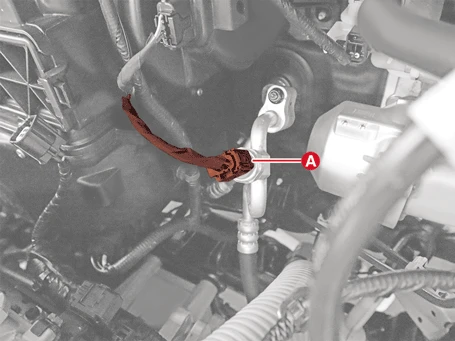
5.Remove the discharge hose (A) after removing the bolt and nut.
Tightening torque :Bolt : 21.6 - 32.4 N·m (2.2 - 3.3 kgf·m, 15.9 - 23.9 lb·ft)Nut : 8.8 - 13.7 N·m (0.9 - 1.4 kgf·m, 6.5 - 10.1 lb·ft)
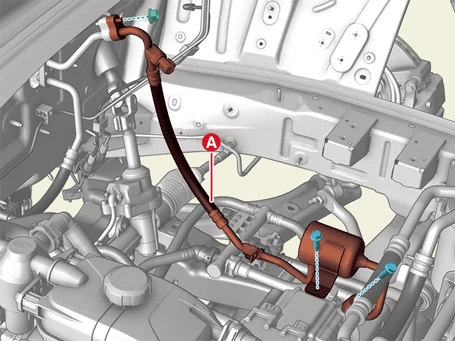
Installation

• When working on high voltage system, the work should be performed by technicians who have completed the relevant training. A lack of understanding of the high voltage system can lead to serious accidents due to electric shock or electric leakage.
• When working on high voltage system or related components, make sure that you are familiar and comply with the "Safety Precautions, Cautions and Warnings." If you do not comply with the instructions, serious accidents due to electric shock or leakage may occur.
• When working on high voltage system, make sure to check the Personal Protective Equipment (PPE) and high voltage shut-off procedures.
1.Install in reverse order of removal.


• When installing a single unit, install it with the specified torque.
• Check for refrigerant leaks by using a gas leak detector.
• Charge the refrigerant after removing the air in the cooling system.
(Refer to Air conditioning System - "Refrigerant Recovery/Recycling/Charging/Vacuum/Leak Test")Removal

• When working on the high voltage system, the work should be performed by technicians who have completed the relevant training. A lack of understanding of the high voltage system can lead to serious accidents due to electric shock or short circuit.
• When working on the high voltage system or related components, be sure to observe and be aware of the "Safety Precautions, Cautions and Warnings". If not, it may cause serious accidents due to electric shock or short circuit.
• When working on high voltage system, make sure to check the Personal Protective Equipment (PPE) and high voltage shut-off procedure.

Suction & Liquid Tube Assembly
1.Disconnect the battery negative ( - ) terminal and the service interlock connector.(Refer to Battery Control System - "Auxiliary 12 V Battery - 2WD")(Refer to Battery Control System - "Auxiliary 12 V Battery - 4WD")
2.Recover the refrigerant with recovery/recycling/charging equipment.(Refer to Air Conditioning - "Refrigerant Recovery/Recycling/Charging/Evacuation")
3.Drain the coolant.(Refer to Cooling System - "Coolant")
4.Remove the front trunk.(Refer to Body - "Front Trunk")
5.Disconnect the chiller hose (A).
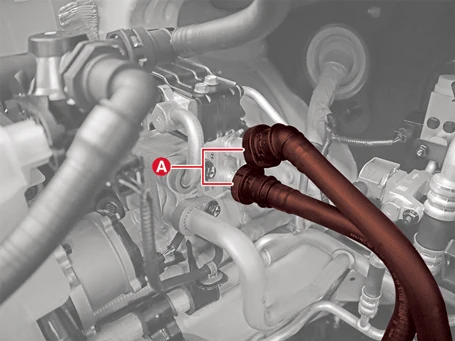
6.Disconnect the expansion valve connector (A).
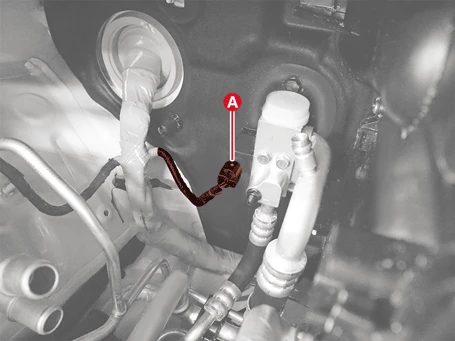
7.Disconnect the 2-way valve connector (A).
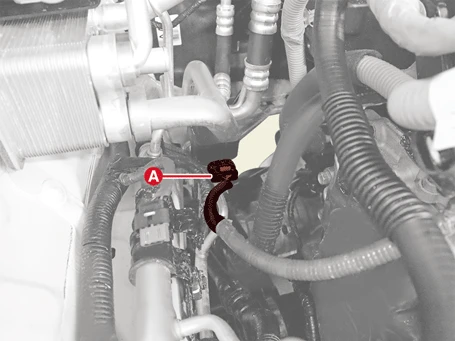
8.Separate the discharge hose assembly (A) after removing the nut.
Tightening torque :8.8 - 13.7 N·m (0.9 - 1.4 kgf·m, 6.5 - 10.1 lb·ft)
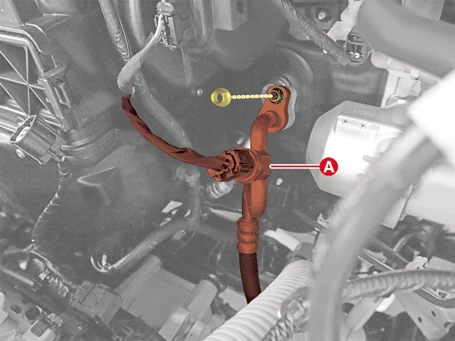
9.Separate the suction & liquid tube assembly (A) after removing the bolts and nuts.
Tightening torque :8.8 - 13.7 N·m (0.9 - 1.4 kgf·m, 6.5 - 10.1 lb·ft)
[Inner Condenser]
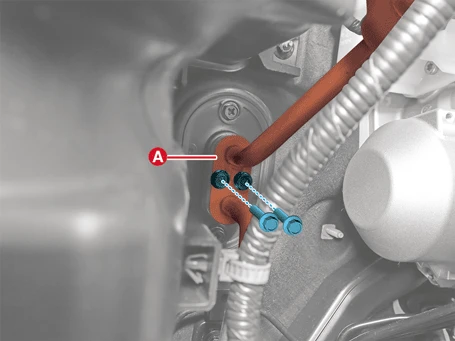
[Evaporator Core]
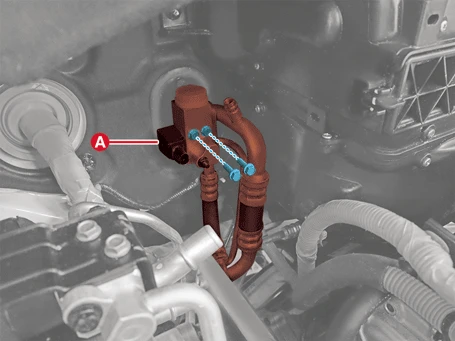
[Chiller]

[Condenser]

[Water Condenser]
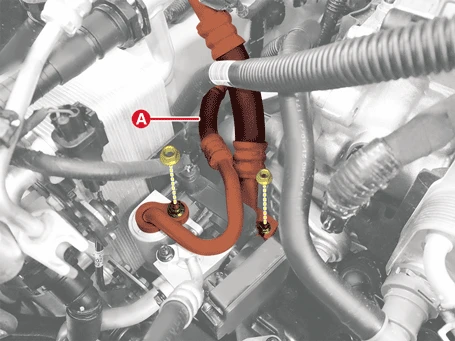
10.Remove the suction & liquid tube assembly (A) after removing the bolt.
Tightening torque :7.8 - 11.8 N·m (0.8 - 1.2 kgf·m, 5.8 - 8.7 lb·ft)
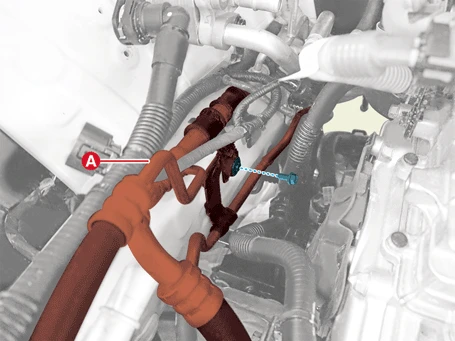
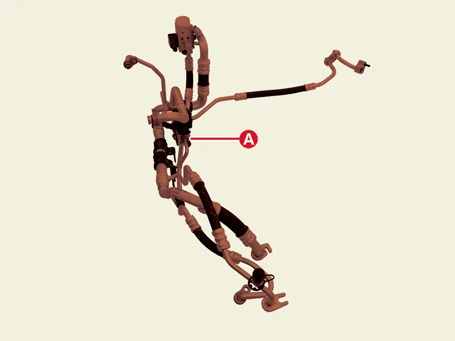
Suction Hose Assembly 1
1.Disconnect the battery negative ( - ) terminal and the service interlock connector.(Refer to Battery Control System - "Auxiliary 12 V Battery - 2WD")(Refer to Battery Control System - "Auxiliary 12 V Battery - 4WD")
2.Recover the refrigerant with recovery/recycling/charging equipment.(Refer to Air Conditioning - "Refrigerant Recovery/Recycling/Charging/Evacuation")
3.Remove the front trunk.(Refer to Body - "Front Trunk")
4.Remove the suction hose assembly 1 (A) after removing the nuts.
Tightening torque :8.8 - 13.7 N·m (0.9 - 1.4 kgf·m, 6.5 - 10.1 lb·ft)
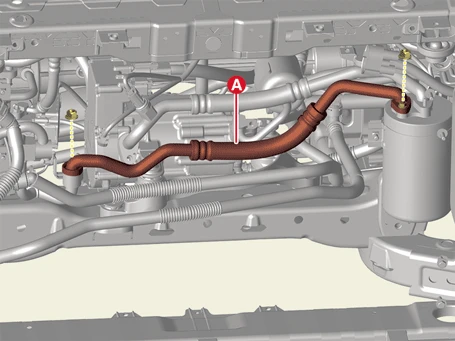
Suction Hose Assembly 2
1.Disconnect the battery negative ( - ) terminal and the service interlock connector.(Refer to Battery Control System - "Auxiliary 12 V Battery - 2WD")(Refer to Battery Control System - "Auxiliary 12 V Battery - 4WD")
2.Recover the refrigerant with recovery/recycling/charging equipment.(Refer to Air Conditioning - "Refrigerant Recovery/Recycling/Charging/Evacuation")
3.Remove the front trunk.(Refer to Body - "Front Trunk")
4.Disconnect the A/C pressure transducer connector (A)
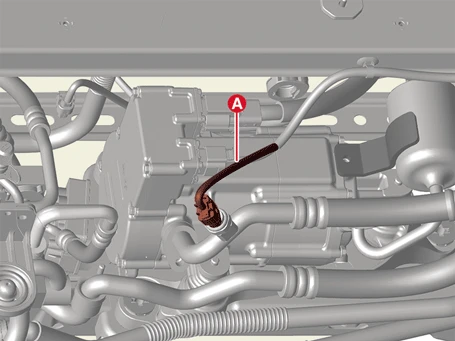
5.Remove the suction hose assembly 2 (A) after removing the bolt and nut.
Tightening torque :Bolt : 21.6 - 32.4 N·m (2.2 - 3.3 kgf·m, 15.9 - 23.9 lb·ft)Nut : 8.8 - 13.7 N·m (0.9 - 1.4 kgf·m, 6.5 - 10.1 lb·ft)
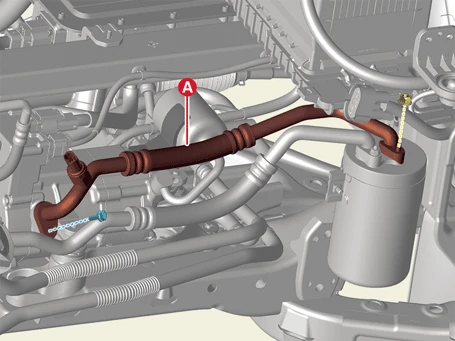
Discharge Hose Assembly
1.Disconnect the battery negative ( - ) terminal and the service interlock connector.(Refer to Battery Control System - "Auxiliary 12 V Battery - 2WD")(Refer to Battery Control System - "Auxiliary 12 V Battery - 4WD")
2.Recover the refrigerant with recovery/recycling/charging equipment.(Refer to Air Conditioning - "Refrigerant Recovery/Recycling/Charging/Evacuation")
3.Remove the front trunk.(Refer to Body - "Front Trunk")
4.Disconnect the A/C temperature transducer connector (A)
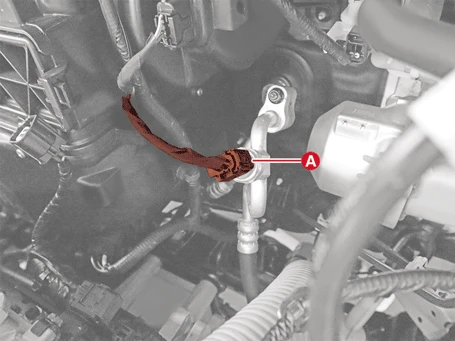
5.Remove the discharge hose assembly (A) after removing the bolt and nut.
Tightening torque :Bolt : 21.6 - 32.4 N·m (2.2 - 3.3 kgf·m, 15.9 - 23.9 lb·ft)Nut : 8.8 - 13.7 N·m (0.9 - 1.4 kgf·m, 6.5 - 10.1 lb·ft)
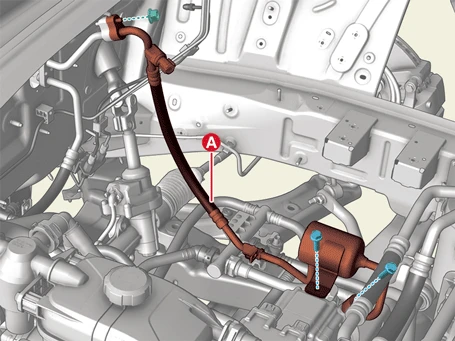
Installation

• When working on the high voltage system, the work should be performed by technicians who have completed the relevant training. A lack of understanding of the high voltage system can lead to serious accidents due to electric shock or short circuit.
• When working on the high voltage system or related components, be sure to observe and be aware of the "Safety Precautions, Cautions and Warnings". If not, it may cause serious accidents due to electric shock or short circuit.
• When working on high voltage system, make sure to check the Personal Protective Equipment (PPE) and high voltage shut-off procedure.
1.Install in reverse order of removal.


• When installing a single unit, install it with the specified torque.
• Check for refrigerant leaks by using a gas leak detector.
• Charge the refrigerant after removing the air in the cooling system.
(Refer to Air conditioning System - "Refrigerant Recovery/Recycling/Charging/Vacuum/Leak Test")